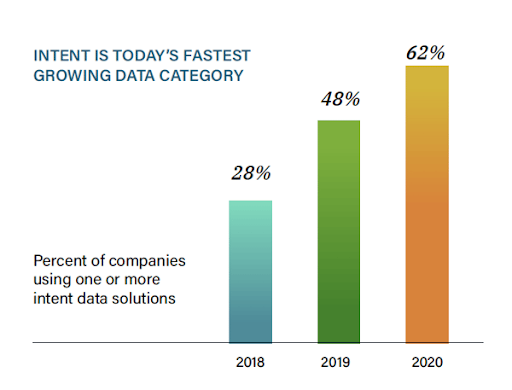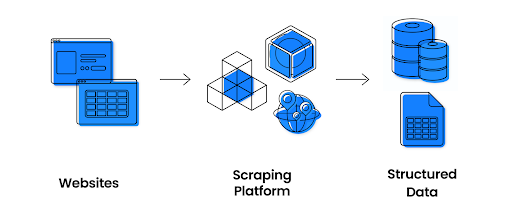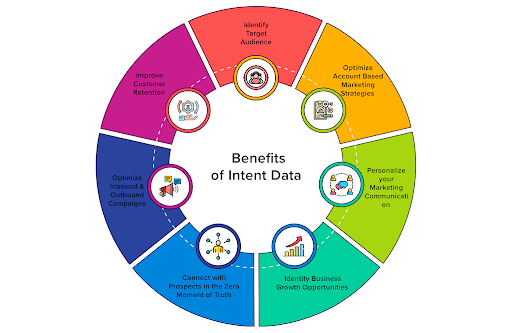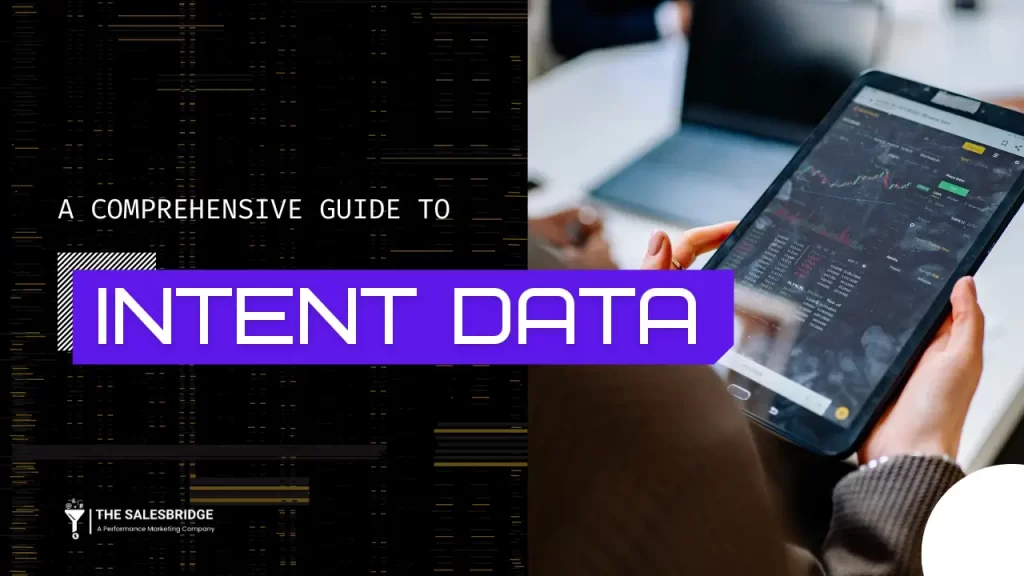What is Intent Data? Being aware of what consumers need or desire is the first and most significant step to building a business. Intent data is crucial for sales representatives to approach them at the right time and ask the right questions in order to keep the customer engaged. As a result, Intent Data helps to analyse consumers’ spending behaviour and approach them accordingly which results in a higher probability of the consumer purchasing the product or service.
Table of Contents
What is Intent Data?
In simple words, Intent Data refers to the data that illustrates a potential buyer’s intent or his/her interest in a particular product or service. This data can be analyzed by studying a prospect’s purchasing behavior such as their recent web searches, Social media posts they showed interest in, etc.
This data can be highly beneficial during the process of Demand Generation as it helps to target potential buyers better.

Popular Sources of Intent Data
You can consider different sources of Data in order to increase sales conversations.
Here are some of them:
Advertisements
Advertisement platforms gather information based on the keywords consumers before engaging with an advertisement. Businesses can utilize this information to provide content and advertisements tailored to these keywords.
Online Searches
Search engines enable you to target prospects through keyword searches. You can utilize this source of data by updating and optimizing your webpage with the keywords that prospects use when they search for a similar product or service.
Content
Businesses can also derive through the type of content that prospects consume. Through this, businesses can provide tailored content, accelerating Marketing-quality Leads (MQLs).
Web Scraping
Web scraping refers to extracting data from a specific website. This is done in order to approach prospects who have a high intent to buy your product or service.
This method can be used to make lists and compartmentalize prospects that are to be targeted.

The Types of Intent Data
Once businesses know the sources of data, they can respond to them effectively and make better decisions.
There are mainly three types of Intent Data. They are as follows:
First-Party
First-party Intent Data is derived through in-house sources such as webpages, blog subscriptions, enquiries, etc. It is sourced from prospects who directly engage with the businesses.
Though first-party intent data can aid in establishing a connection between businesses and their prospects, it may fall short in accumulating a complete consumer experience.
Second-Party
Collaborating with a firm that generates revenue through its own first-party data is another excellent alternative for businesses seeking to go beyond the bounds of first-party intent data. This is called second-party intent data.
Third-Party
Businesses can find third-party intent data from data aggregators that buy intent signals from various web pages and structure the data as a means to monetize it. The best means of reaching the target audience is via this sort of intent data.
First-party intent data vs. Second-party intent data vs. Third-party intent data
First-party: As companies have complete authority over data and its extraction, they can avoid interacting with third parties and save time and money.
It is incredibly beneficial for prospects who already have a good understanding of the business.
Second-party: The sources from which this kind of data is currently accessible are few and far between. The basis for this type of data can be easy as accumulating first-party data through a source and sharing it with other companies.
Third-party: It is freely accessible to anyone who purchases it. Competitors can also get access to the same account details and target similar prospects.
Why is Intent Data important?
In today’s Sales and Marketing environment, intent data is deemed to be important due to these major reasons:
Account-based Marketing
When it comes to Account-based Marketing (ABM), businesses focus on high-quality leads that have the highest probability of converting into permissible leads.
This strategy involves a thorough understanding of the target clients, their spending capacity, needs and pain points.
As a result, you can aid to get judgements about these accounts so that you can customize your marketing and sales strategies to ensure a successful deal.
Inbound Marketing
The main intention of inbound marketing is to acquire new prospects and convert them into long-term clients.
This is achieved by offering them the answers to the questions they ask on the internet and presenting them with customized solutions to their pain points.
Therefore, intent data enables businesses to produce content that prospects are searching for.
Benefits of Intent Data
According to Insights by Professionals, about 40% of businesses spend more than half of their marketing budget on intent data. It as become increasingly significant in the B2B environment over the past few years.
Let us take a look at how it is beneficial to B2B marketing:
Acquiring prospects efficiently
Every business development strategy should ideally start with increased Lead Generation which helps to scale up growth. In order to achieve a high growth scale, businesses must be able to draw in as many prospects as possible with minimal resources.
It helps to shorten the sales cycle, assisting businesses to acquire prospects efficiently through customized Lead Generation, Email Marketing, Digital Marketing, and other marketing campaigns.
Enhanced Customer Acumen
Through this data, businesses can get an understanding of what prospects intend to purchase and can approach them with offers accordingly.
As a result, businesses are able to get enhanced customer insights into what they want to buy and present them with an ideal offer at the right time.
Increased significance and pertinence
With being offered customized solutions, the outreach endeavors and efforts of a business are acknowledged which leads to customer loyalty.
Valuable feedback
Businesses can actually seek valuable feedback about their product or service through intent data.
If they do lose prospects, intent data can help businesses trace what went wrong, the reasons for customer disinterest and how they can work on the problems, make the necessary changes and optimize the processes.

The Future of Intent Data
At times, B2B transactions involve various decision-makers, all of whom have unique needs and goals. businesses can ensure that they provide relevant information at the correct time and guide prospects through the sales funnel.
Any marketer or sales representative who aspires to have a high success rate or is continually seeking strategies to advance must be aware of the prospect’s purchasing intent. With this information, marketing and sales personnel may go after a specific profile and approach them with a customized strategy in order to maximize the possibility of a purchase decision.
It can be used for prospecting in the future since they highlight particular trends and play a major role in influencing a prospect’s decisions along his/her buyer’s journey.
It is important when it comes to the B2B marketing atmosphere, businesses should highly consider assessing their current stance and plan future strategies ahead of time.
Wrapping it up
Just like any other data, B2B intent data tends to perform optimally when combined with additional sources of data in order to create an ideal model.
In the end, when utilized properly, it can deem to be a strong indicator of accounts likely to make a purchase.





